We occasionally link to goods offered by vendors to help the reader find relevant products. Some of these may be affiliate based, meaning we earn small commissions (at no additional cost to you) if items are purchased. Here is more about what we do.
Are you in the market for a new set of cookware? If so, you might want to keep reading to learn a little about an option with which you might not yet be familiar. I’m talking about carbon or “black” steel cookware.
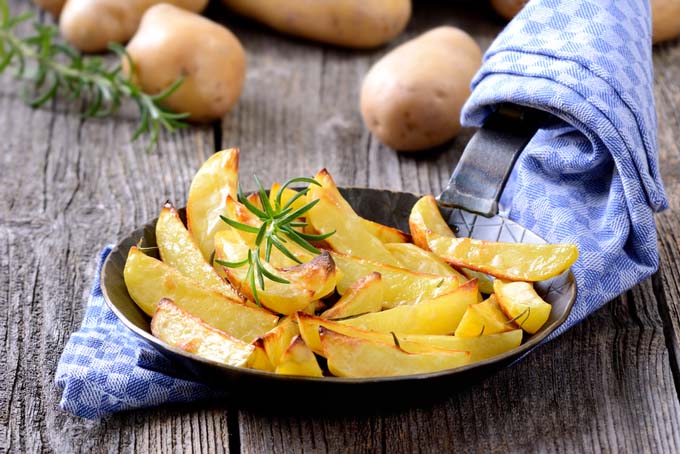
Similar to cast iron, carbon steel is comprised of both iron and carbon. It has similar qualities to cast but with enough minor differences that it might be a more appealing option to you if you are looking for something a bit lighter and faster reacting to differences in temperature.
Weight
The most obvious difference between carbon steel and cast iron is weight. If you have ever had to pick up a cast iron Dutch oven, you know just how heavy this material is. The skillets are not too much lighter, for that matter.
The reason for the heavy weight is that iron is pretty brittle, so they have to use more of it to make it durable. Carbon doesn’t have that issue, though, so most pans made from this metal are significantly lighter.
There are a couple of different weights available, though. Carbon steel cookware is available in 2mm or 3mm. 3mm is heavier and closer to the weight of iron.
Response
The thickness also makes a difference in a couple of other areas. The thickness is what helps cast iron to have such even cooking, so carbon steel is not quite as good in that department.
On the flip side, the thinner material of the carbon steel means it heats up faster.
Additionally, due to this same reason, steel is much more responsive to changes in temperature. If you’re cooking in a iron pan and realize you have the heat a little high, it will take a good bit of time, relatively speaking, for the skillet itself to cool down to the temperature you need.
This is not an issue with a thinner product with less mass that will retain heat. Also, both of these types of material work very well on the newer induction stoves that have recently became very popular.
Appearance
The final really noticeable difference is in appearance. Everyone is familiar with the chunky, rough look of cast. Carbon steel is on the opposite end of the scale, being sleek and smooth and, at least when you first get it, nice and shiny.
With use, it with blacken, especially on the inside where you layer of seasoning builds up.
Both types of frying pan need to be seasoned before the first use. With appropriate seasoning, both these types of cookware become as nonstick as any Teflon coated pan out there and are safer to boot.
I have heard that it takes longer to build up the right level of seasoning on a cast vessel than on carbon, but, not having witnessed this firsthand myself, I can’t really verify the veracity of that.
Some cooking forums I frequent also led me to some reviews of both these products that argue that, while it may take a little longer to get the cast as nonstick as a carbon product, the seasoning lasts better in the iron.
So, there are pros and cons to using carbon steel, but, overall, it’s a pretty good option that you may not even have considered.
It’s especially good for woks and crepe pans, since you really need the better temperature control that carbon steel affords, and, if the heftiness of cast is an issue for you, it’s the best for a skillet that you’ll be using for higher temperatures.
It’s worth pointing out, though, that neither iron nor steel should be used to cook with anything acidic, like tomato sauce or wine, as these will react with the pan and give your food a metallic taste.

Paderno World Cuisine 9 1/2-Inch Carbon Steel Crepe Pan
Who are the Makers?
If you think you might be in the market for some carbon steel to add to your kitchen, you may be wondering which manufacturer is the best for you.
Well, the answer may surprise you.
Unlike some other types of cookware (I’m thinking here of stainless steel, where the difference in quality, as well in price, in the options is pretty substantial), carbon steel is carbon steel. They are all made the exact same way.
It’s going to come down to reputation or price point.
It seems like all the top-quality gastronomic paraphernalia always comes from France. I guess that’s appropriate for a country known for its food. The French love affair with food goes back centuries, so it’s no surprise that they would make some of the best cookware in the world.
This holds true if you’re looking to invest in some really nice, made to last for life carbon steel cooking vessels, and there are a few different brands that really hit the mark for me.
For reputation, you really can’t beat the de Buyer brand. This world-renowned French manufacturer has been making top-notch cookware since 1830 and is a staple in many professional kitchens.
It seems like every serious cook I know has at least one de Buyer pan in their kitchen, and for good reason.
They cook eggs like a dream, make amazing grilled cheeses, sear steaks to perfection, and even make a copper pan that can be used on induction (a feat previously unheard of); I could go on and on! You see, de Buyer found out a little secret that is the reason I think they make the best carbon steel products out there.
They started coating their cookware with beeswax, which not only helps to protect against oxidization but also helps to assist in seasoning. Amazing, huh?
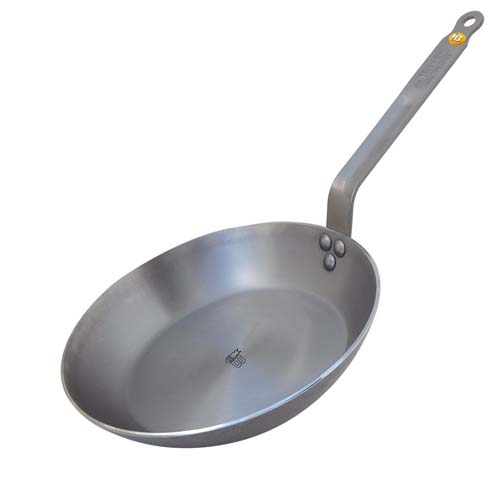
DeBuyer Mineral B Element Iron Frypan, 12.6-Inch Round
So, if I was going to insist that you pick a certain pan to go buy right now, I would say buy a de Buyer Mineral B 12.6” frying pan. It won’t break the bank, and you’ll be well on your way to having a set of cookware that you can be proud of. As of the last update to this article, it has over 330 reviews on Amazon.com with consistently high marks in regards to its quality and heavy duty construction.
However, just because I am a little biased when it comes to de Buyer, there are actually a couple of other French brands that are (almost) as good. Mauviel, who has also been around since 1830, is a renowned copper cookware manufacturer who recently started producing a carbon steel line that’s getting rave reviews.
You can find a Mauviel M’steel 12.5” frying pan on Amazon for a price that’s comparable to the de Buyer.
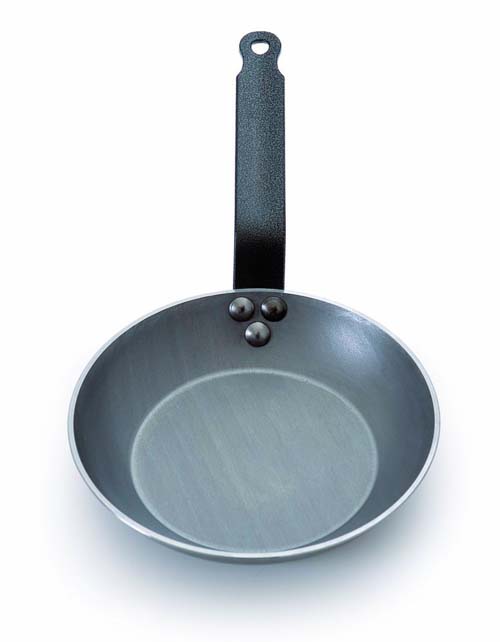
Mauviel M’steel Frying Pan, 12.5-Inch
Lastly, we have Matfer Bourgeat, who has been in the business since 1814. Their carbon steel line is also impressive, and you can get their 11” frying pan through Amazon.
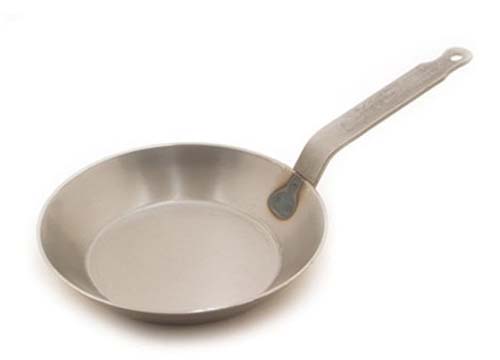 Matfer Bourgeat Black Steel Frying Pan, 11″ dia.
Matfer Bourgeat Black Steel Frying Pan, 11″ dia.
These French-made examples are all comparable in price. Though you can get a slightly larger pan from de Buyer for this amount, any of these is a great option.
To be fair, I want to list two other brands on the lower end of the spectrum when it comes to price. My beloved Lodge, maker of my two cast iron skillets and my huge Dutch oven, also has a carbon steel line now that comes pre-seasoned.
It’s a little more budget-friendly, and positive reviews from customers on Amazon.com, this may put this pan into serious contention if you want to try out this type of cookware without overspending.
I do know that their carbon steel is more similar to cast iron in appearance than any of the other products I’ve ever seen, so I guess that would account for the pretty substantial price difference. The fact that it is made in the USA is another plus.

Lodge CRS12 Pre-Seasoned Carbon Steel Skillet, 12-inch
Another lower-end option comes from Paderno, which I only include because it’s manufactured on Prince Edward Island, home of Anne of Green Gables. (The book-lover in me insisted upon it!) Canada’s only cookware manufacturer, Paderno has been crafting excellently-rated products since 1979 (everything in North America is always so much younger than its European counterparts!), and I’ve heard nothing but good things about them.
Their 11” frying pan is also affordable, and with many positive reviews from verified customers on Amazon.com, the Paderno closely matches the Lodge offering. These are also available in smaller sizes and one bigger size at 12.5″.
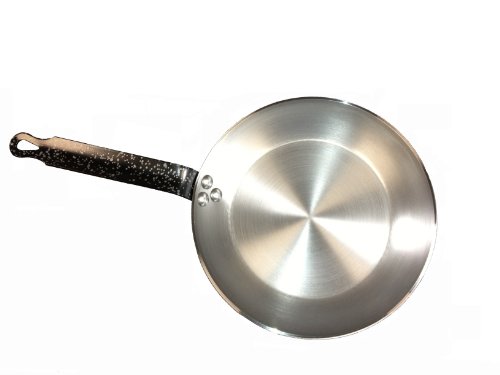
Paderno Heavy Duty Carbon Steel 11 Inch Frying Pan
And there you have it. Carbon steel really is a great option for the kitchen, and it may not have even been on your radar before now.
About Ashley Martell
Ashley has enjoyed creative writing since she was six years old, when she wrote her first short story. She majored in English literature at the University of Montevallo. After years of professional work, she is now a stay-at-home mom of three, who uses her craft to write about her life and adventures in and out of the kitchen.

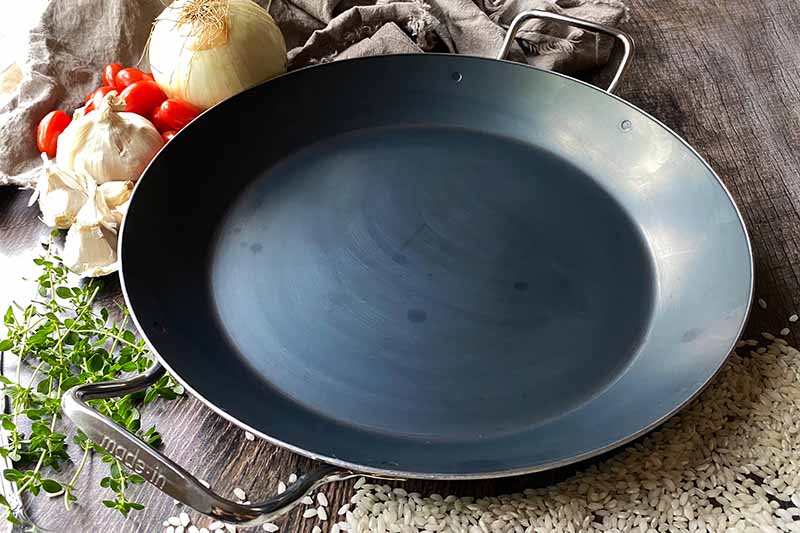

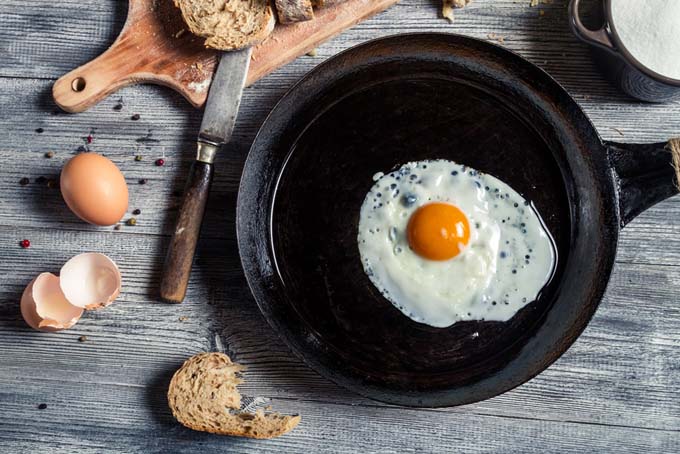
Carbon Steel pans are not an option that I have ever considered. For my quick cooking style, a design that can heat up quickly with a lighter weight and attractive looking cookware would be best for me. Yes, cast iron pans are flaky and it is difficult to remove bits of food by hand out of those crevices. Ashley, I am glad to have learn of another cookware option.
They will be the first one you reach for took me three times to get seasoned right but well worth it my mistakes I purchased made in the USA union construction worker
I have never heard of these before. The one in the first image looks pretty slick! I will have to look into getting one–sometimes I get impatient waiting for my big cast iron to heat up. It can also be hard to lift it in and out of cabinets.
Wow, I can see the purpose for this! Also… how about sharing that recipe for the potatoes with rosemary!? Yum!!
I think we can figure out the roasted potato and rosemary…
These are interesting pans, great pictures as always, gave me some ‘food for thought’ on amazon looking through some of the reviews and has given me some ideas.
I’ve never really given carbon steel much thought. I think it would be great to see a side by side cooking of the same dish. Personally I love the flavor you get out of coking with cast iron. Seems like carbon steel might be more on par with regular pots and pans flavor-wise.
I second wanting the recipe for the rosemary potatoes pictured here!
No, carbon steel pans have a seasoning- just like cast iron. Food tastes exactly the same from both, but one is lighter and easier to clean.
I bought a carbon steel wok last year, to replace an old aluminum with chipping Teflon one we christened The Death Wok. I was surprised by how light it was for a pan its size. I didn’t realize at first that it should be seasoned, so I washed it a few times, and it started to oxidize. Yikes! I rubbed it down with oil, and let it dry on the warm stove top a few times, and it was good as new. I really love it, and it gets a lot of use.
How I wish I had stumbled on this page before buying the one I’m am tied to right now…these look amazing…the one I have can be a pain at times {during washing}…anyway, enough of the complains, I ‘ll just save up some money and buy some at Amazon…i hope that, it will be soon 🙂
Where can I find that black french steel pan in the first picture with the rosemary potatoes. I have a small skillet that I love but I would really like a bigger one and that one looks perfect. I have searched the web and cannot find any one like that. Thanks in advance for your help.
Look at the inside surface of the pan in the picture, there is a pattern cut into the surface, MINERAL B Round Carbon Steel Steak Fry Pan 11-Inch on Amazon has the same cuts in the Surface,
Carbon-steel skillets are perfectly fine by me, as long as I’m not forced to change them quite as often. It takes time to familiarize yourself with their ‘personalities’. Temperature differences like how fast the pan heats up can be one of the trickier ones to master.
I never considered this type of cookware until I read your blog. We are changing to induction cooking soon and I am pretty much set already steel clad, enameled iron and cast iron cookware but am interested a a few lighter weight pieces. Will check out one of your suggested frying pans. Can you, or anyone here, recommend a carbon steel wok?
Thank you
Wow some of those are incredible. Look like flat plates. I need a good one for cooking breakfast that won’t stick so this helped a lot.
I too have never heard of these type of pans. I love my 12 inch cast iron skillet and use it for pretty much everything. It might be nice to find a carbon steel wok though for all the Asian cooking we do. Any suggestions on a good one?
America’s Test Kitchen did an extensive review of carbon (aka black) steel pans and said they performed as well or better than cast iron. They also stated that after just one or two uses, eggs will slide around in these pans like a hockey puck. As the proud owner of both 12″ and 14.5″ carbon steel pans, I can attest that this is no exaggeration.
They also clean up much easier than cast iron because of their smoother surface. They found that acidic ingredients did not affect the patina for shorter cooking times- like a weeknight 20 minute pasta sauce.
Perhaps prices have come down since this article was written, but I only paid $40 for the 12″ and $60 for the mammoth 14.5″- both by Matfer Bourgeat (ATK’s winning brand). The handles are welded on and thus rivet-free, making for a perfectly smooth interior and cleanup even easier.
Even ATK mentioned that most American home cooks don’t know about carbon steel, although restaurants everywhere use them. I’ll never buy a fragile and limited life coated non-stick pan again.
I use chef inox black steel pans they are lighter than the de Buyer pans but on gas perfect. Just a word of warning if you have an induction cooker you need 3mm+ base on black steel or they will warp. de Buyer clearly states which you can and cannot use in induction.
from the debuyer website for the mineral and carbone lines: ” All cook tops including induction”
trying to figure what the difference between the two lines is though. Is it just the mineral coating on the mineral line ?
The differences aren’t enormous but can make a huge difference. The mineral line has an epoxy coating on the handle which I have seen melt if putting the pan in the oven. The carbone plus line is listed as being slightly thicker, and doesn’t have the epoxy coating on the handle. Note that the mineral b french collection and professional collection have stainless steel handles making them a better choice if you use your pan in the oven.
Do these pans put iron your food like cast iron?
Thanks for your question, Betty. Carbon steel will impart some iron into whatever you cook in it. But you shouldn’t rely on this the same way you would a supplement – iron-rich foods are the best sources of bioavailable iron.
If wine and tomato should not be used with these pans, how do you deglaze the pan after cooking meat? I usually put in a good splash of Madiera and sometimes a few plum or grape tomatoes, some herbs, and butter for an easy, tasty sauce. Can I do this with the carbon steel pans?
Great question Judith – If your pan has a good patina, it will prevent the transfer of any metallic tastes when a little splash of wine or tomatoes are used in a sauce.
If the pan doesn’t have a good coating, suitable non-acidic alternatives for deglazing are any type of broth (beef, chicken, fish, vegetable) or non-acidic fruit and vegetable juices.
The key with using acidic ingredients in a seasoned pan is brevity.
A thick, heat-set patina will be able to handle the occasional encounter with liquid acids for a few minutes – but you don’t want them simmering in the pan for 20-30 minutes, as extended exposure will destroy the layers of seasoning. Thanks for asking!
The Paderno Heavy Duty Carbon Steel 11 Inch Frying Pan that you refer to is not made in PEI by Paderno Canada but by Paderno World. They are two totally different companies.
Paderno Canada does at the present not produce Carbon Steel cookware.
I tried a Mauviel pan against a Blue Skillet pan. I hate to write this but the Blue Skillet pan out performs the Mauviel. I realize the price difference is astronomical. I was wondering if you have tried high end carbon steel pans against affordable ones?
You mentioned that Cast Iron has excellent even heat distribution due to the thickness but really cast iron is a poor conductor of heat hence the need to increase the thickness. Without this mass the thinner carbon steel pans, being made of nearly the same material as you point out are even worse. Article below does a big comparison, i found very interesting. Nothing beats very conductive metal sandwiched by stainless. I suspect the better stoves will reduce the delta while induction is actually worse which surprised me. Still, it doesn’t mean i’ll give up my cast iron or carbon…
https://www.centurylife.org/cookware-even-heating-rankings-butane-propane-natural-gas-etc/
So I looked at all the French models, most running around $90 for a 12″. Sur La Table carries a line called BK for about 3rd less, I picked up the 12″ model for $59. Like you say Carbon Steel is carbon steel. I haven’t figured out all the pro’s and con’s. All I know is I like 3 lbs vs. 7 lbs. I’ll probably continue to use cast iron for steaks. And experiment with the carbon steel pan on everything else. I still use ScanPans for eggs.
FYI, I started with my Chinese carbon steel wok about 6-7 yrs. ago, so I know about seasoning, which is the same all 3 types of steel pans.
Can you add BK from Sur la Table and the new and much hyped MadeIn pans to your assessments?
You can read our review of the carbon steel wok from Made In here. We hope to add reviews of other pans in their carbon steel collection in the near future!
Good review of the Steel pans. However, not one mention of flat bottoms. The reviews on Amazon, for all the brands, do not have flat bottoms. Not a good selling point. That is the reason I have been looking at steel pans, FLAT Bottoms that stay flat.
Does anyone on this blog have experience with the Australian Aus-Ion pan? It looks great. There’s also a new carbon steel pan on Kickstarter that looks interesting.
I think this is enough durable.
For anyone struggling to find good supplier of carbon steel pans in the UK I’ve just found clnry and thought I’d share (clnry.co.uk). Have always struggled to find a good supplier of Carbon steel pans in the UK. Typically buy from Amazon but tends to be foreign sellers, have issues with delivery times.
Be aware that the de Buyer (pronounced dee-boo-yeh) Mineral B pans are limited for oven use. Because the handles have an epoxy coating, you can only flash the pans for 10 minutes at less than 10 minutes. This is essential for many recipes and a real deal-breaker for me. de Buyer also has a line of carbon steel without the epoxy coating on the handles which are safe for unlimited oven use at higher temps, but they are harder to find.
Also note: The Matfer Bourgeat, despite its French sounding name, is made in the U.S., if that’s important to you. I’m not crazy about the sharp angle of the sides, though I can see it being useful when cooking something like omelets, or where you want the dish to slide easily out of the pan. On the other hand, the food could just as easily slide out of the pan in the middle of cooking. Some chefs swear by them though.
There is no one pan for everything. Cooking something acidic (i.e. tomatoes, wine, or stone fruit)? You want stainless steel. Searing steaks? You want cast iron or carbon steel. Making a delicate sauce where temperature control is key? A copper covered stainless steel is what you want.
I have a Matfer 12 inch and an 8 inch Maidin. The Matfer is far and away better, I am going to get a de buyers either a 10 inch or possibly the big one 13 inch. In my opinion the 8 inch ones are not very practical
So true! Carbon steel skillets will buckle upwards if the heat element is too big by differentials heating the edges, or buckle downwards to a rocker bottom if the heat element is too small, in the middle. I trashed two carbon steel skillets before I figured this out, and have gone back to Lodge cast iron. Not nearly as temperamental as carbon steel
I bought a Matfer 11″ lamb and found it fairly heavy. I ended up trading for a new Oxo brand pan which is similar to the BK pans. Some say they are too thin. We shall see…
The naming of these pans leads to a lot of confusion. ‘Cast Iron (CI)’, ‘Carbon Steel(CS) and Stainless Steel (SS) pans are all steel pans. Iron is a metal element. In comparison, steel is a man-made alloy that’s made by mixing iron and carbon together. The first two types of pans would be better described as, high carbon steel and low carbon steel. It is the higher carbon content in CI that make it more brittle, requiring a “cast” construction method and thicker form factor.
Steel is not particularly efficient in terms of quickly and evenly distributing heat.
SS is also an alloy of iron and carbon to which additional elements are added to inhibit the steel from oxidizing. Clad SS refers to cookware constructed by packaging it with other metals (aluminum, copper …. ) to address the heat distribution limitations in steel pans.